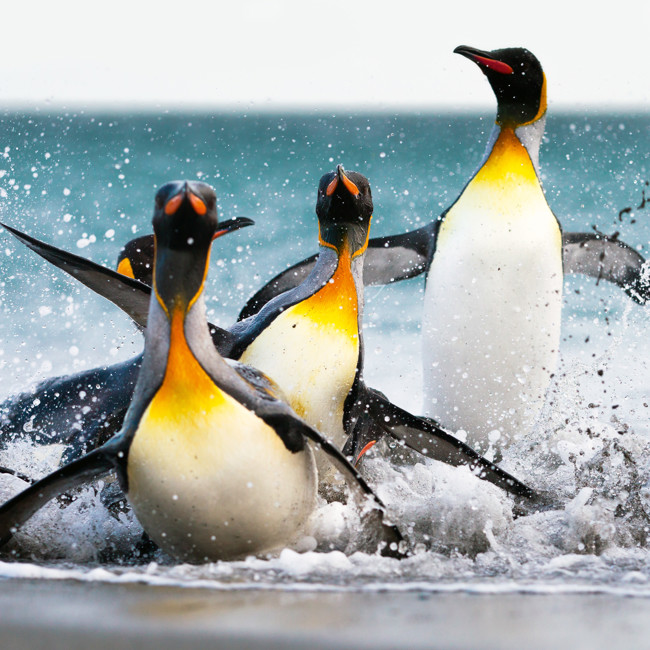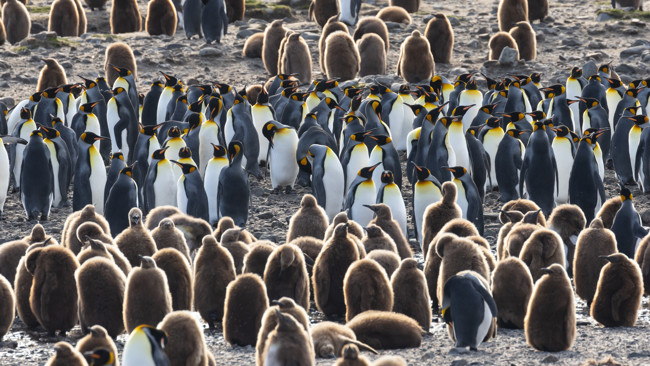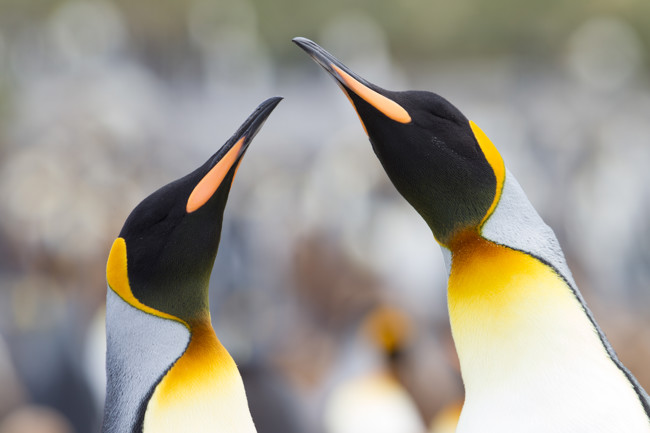With its majestic posture and elegant plumage, the king penguin is one of the world’s most iconic birds. It lives in vast colonies on remote, windswept islands in the Southern Ocean and spends most of its life at sea. During our grand Antarctic voyage, you’ll have the chance to witness hundreds of thousands of king penguins gathered on the beaches of South Georgia – an unrivalled nature experience. In this blog post, you’ll get to know this fascinating penguin species a little better.
Second largest in the world
The king penguin grows to about 90 cm (3 feet) in height and weighs on average between 11 and 16 kg (24–35 lbs), making it the second largest penguin species after the emperor penguin. The name “king” actually dates back to a time when it was believed to be the largest penguin species. This notion was revised in 1884 when the emperor penguin – which can grow nearly a foot taller – was recognized as a separate, even larger species.
A splash of colour
The most striking feature of the king penguin is the bright orange-yellow patch on its neck and cheeks. These colors become even more vivid during the breeding season, serving as an important part of the penguins' courtship display.
Endurance divers and swimmers
King penguins are impressive underwater hunters. They can dive to depths of over 300 meters (1,000 feet) and stay submerged for more than five minutes while hunting fish and squid. During the foraging season, king penguins can spend weeks out at sea, swimming hundreds of kilometers to reach areas rich in food, far from their colony.


How they care for the egg
Unlike the emperor penguin, both the female and the male king penguin share the responsibility of incubation. The egg is kept warm on the parent's feet beneath a fold of skin (called a brood pouch), and the parents take turns guarding it, often switching every two to three weeks. Meanwhile, the other parent is out at sea, feeding and building up energy for the next shift.
Social “crèches”
King penguin chicks gather in large groups, known as crèches, to stay warm and protected from predators while their parents are out hunting. These groups can consist of thousands of chicks.
Seasonally monogamous
King penguins typically form pairs for a single breeding season, but unlike some other bird species, they do not mate for life. They often return to the same colony each year and may reunite with the same partner for several seasons in a row – if both survive and arrive at the same time. However, if one partner fails to show up in time, the other will usually choose a new mate.
Long rearing period
It takes up to 14–16 months from the time the egg is laid until the chick is ready to head out to sea. This unusually long rearing period often causes breeding cycles to overlap.


Age
A king penguin can live up to around 25 years in the wild, although many don’t reach that age due to predators and harsh environmental conditions. In captivity, where these risks are absent, they can sometimes live even longer.
Massive colonies
St. Andrews Bay on South Georgia is home to one of the world’s largest king penguin colonies, with over 150,000 breeding pairs. When all adults and chicks are gathered, the number of individuals can exceed half a million.









